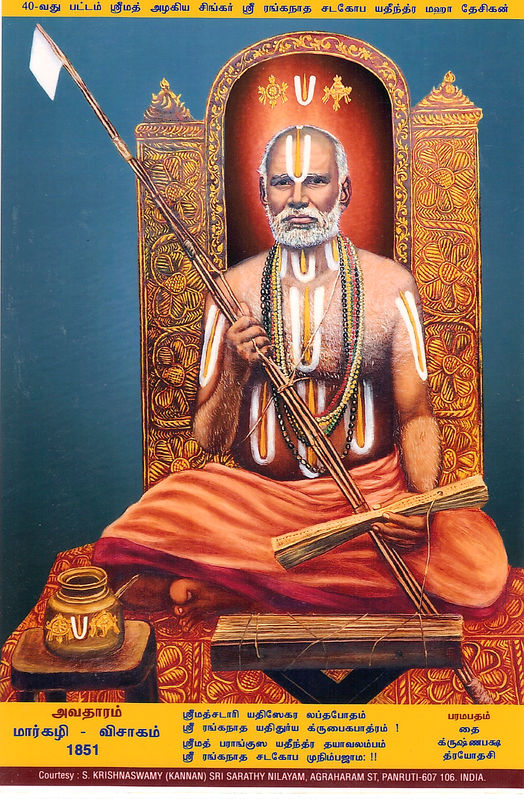The 159th Thirunakshatram of HH 40th Srimath Azhagiyasingar was celebrated in a grand manner at Srirangam Sri Ahobila Mutt on December 29, 2013; Vijaya Varusha Margazhi Visakam. Veda and Prabandha parayanam commenced at 6:30 am and an elaborate sattrumurai took place at around 9:30 am. Several sishyas and abhimanis participated in the utsavam and received the blessings of Acharyas and Sri LakshmiNarasimhan.
Acharya Vaibhavam
 Ahobila Mutt’s glory rose to greater heights during the stewardship of the HH 40th Azhagiyasingar, Sri Lakshminarasimha Divya Padukasevaka Srivan Satakopa Sri Ranganatha Satakopa Yatheendra Mahadesikan. Known as Karaikurichi Vankeepuram Vidwan Venkata Krishnamacharya in his poorvasrama, he ascended the Peetam on 17th April 1913 and came to be sought by scholars and laity alike because of his genial temperament as also by his great psychic power. Since some of the earlier Azhagiyasingars could not visit Ahobilam, he more than made up for them and Venkatesa Ayyar in his History of Ahobila Mutt says, ‘Here is a clear case of HE CAME - HE SAW - HE CONQUERED. No other Azhagiyasingar had undertaken so extensive a travel as this Jeeyar - all for the sake of devotees welfare. His visits extended upto Hyderabad. He stayed at Ahobilam for quite sometime restoring the worship and renovating the temple structures.
Ahobila Mutt’s glory rose to greater heights during the stewardship of the HH 40th Azhagiyasingar, Sri Lakshminarasimha Divya Padukasevaka Srivan Satakopa Sri Ranganatha Satakopa Yatheendra Mahadesikan. Known as Karaikurichi Vankeepuram Vidwan Venkata Krishnamacharya in his poorvasrama, he ascended the Peetam on 17th April 1913 and came to be sought by scholars and laity alike because of his genial temperament as also by his great psychic power. Since some of the earlier Azhagiyasingars could not visit Ahobilam, he more than made up for them and Venkatesa Ayyar in his History of Ahobila Mutt says, ‘Here is a clear case of HE CAME - HE SAW - HE CONQUERED. No other Azhagiyasingar had undertaken so extensive a travel as this Jeeyar - all for the sake of devotees welfare. His visits extended upto Hyderabad. He stayed at Ahobilam for quite sometime restoring the worship and renovating the temple structures.
His psychic powers and Mantra Siddhi were utilised by the then Gadwal Raja to regain his royal, financial and spiritual powers. The 40th Jeeyar-Sri Ranganatha Satakopa Yatheendra Mahadesika (1913-1923) visited Gadwal after a long interval. Apart from being an erudite scholar, he was credited with great psychic and mystic powers like the 1st, 6th and 25th Jeeyars. When he reached Gadwal, the 40th Jeeyar found to his dismay that the place had become one of total inactivity. It seems that when the Kesava temple was built, a human (Brahmin) sacrifice was made and that as a consequence, Soma Bhoopal had incurred a curse whereby he was left without a progeny. From that time onwards his successors in line were all by adoption only. Not even a female child was born, leave alone a son. When Sriram Bhoopal ascended the throne, the temple had become a haunted place as also the Gadwal palace and the Raja had moved to Hyderabad where he had a palace and other properties. In a bid to set right things, the Jeeyar sent word to the Raja at Hyderabad who promptly came back to Gadwal with his family. This Jeevar’s son was a great scholar with Mantra Siddhi and with his help the place was duly sanctified. The Jeeyar on visiting the Kesava temple found the Moola Vigraha (idol) deformed and wanted it to be removed. The Raja and other learned Brahmins were reluctant to do so for fear of incurring the wrath of the God once again. Undaunted, the Jeeyar, it is said, himself went about the job. He tied a rope round the idol and the other end of the rope was tied round a bullock which dragged the idol out of its place. The Vigraha was then buried in the sands of the river Krishna and that place is known as Erra Banda since then. A new vigraham of Kesava with Sreedevi and Bhoodevi on His either side was obtained from Srimushnam, a Swayamvyaktha Kshetram of Tamil Nadu and duly installed at the temple situated in the fort of the Gadwal palace. A number of Ahobila Mutt disciples once again settled down in that town and the era of bubbling and bustling activities began again. The Jeeyar stayed at Gadwal for three years. The grateful Raja of Gadwal honoured the Jeeyar with jewels to the Lord Lakhsminarasimha and gave other properties.
The following are some of the photographs taken earlier today…
Video:






Good coverage of the event. KEEP IT UP!